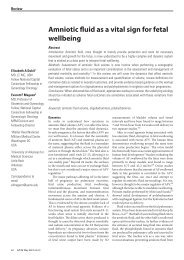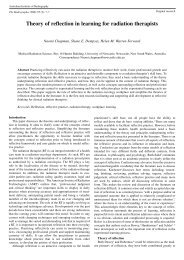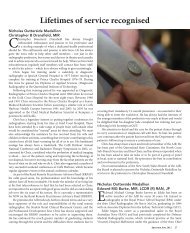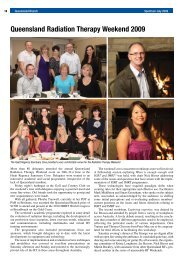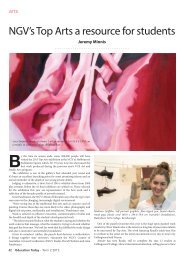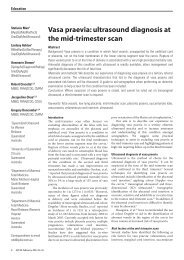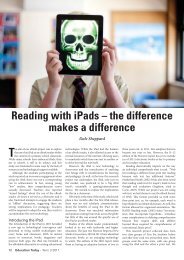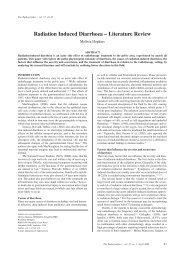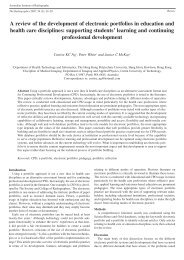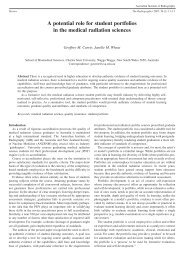Nobel Prize for CT and MRI pioneers - Minnis Journals
Nobel Prize for CT and MRI pioneers - Minnis Journals
Nobel Prize for CT and MRI pioneers - Minnis Journals
Create successful ePaper yourself
Turn your PDF publications into a flip-book with our unique Google optimized e-Paper software.
<strong>Nobel</strong> <strong>Prize</strong> <strong>for</strong> <strong>CT</strong> <strong>and</strong> <strong>MRI</strong> <strong>pioneers</strong>The Radiographer Figure 1Figure 2On 12th August, 2004, Dr Hounsfield passed away. He will beremembered as the individual whose invention has a significantimpact on the practice of radiology.Allan MacLeod CormackAllan MacLeod Cormack was born in Johannesburg, SouthAfrica, in 1924. He attended the University of Cape Town wherehe obtained a Bachelor of Science in Physics in 1944, <strong>and</strong> earneda Master of Science in Crystallography in 1945. He subsequentlystudied nuclear physics at Cambridge University be<strong>for</strong>ereturning to the University of Cape Town as a physics lecturer.He later moved to the United States <strong>and</strong> was on sabbatical atHarvard University be<strong>for</strong>e joining the physics department at TuftsUniversity in 1958.Prof Cormack developed solutions to the mathematical problemsin <strong>CT</strong>. Later in 1963 <strong>and</strong> 1964 he published two papers theJournal of Applied Physics on the subject, but they received littleinterest in the scientific community at that time. It was not untilHounsfield began worked on the development of the first practical<strong>CT</strong> scanner that Dr Cormack’s work was also viewed as the solutionsto the mathematical problem in <strong>CT</strong>. Cormack died at age 74,in Massachuetts on 7th May, 1998.In South Africa, Dr Cormack was granted The Order ofMapungubwe, South Africa’s highest honour, in December 2002,<strong>for</strong> his contribution to the invention of the <strong>CT</strong> scanner.For a photograph <strong>and</strong> more details of Dr Cormack’s contribution<strong>and</strong> the <strong>Nobel</strong> lecture, readers should refer to the <strong>Nobel</strong>Website at http://www.nobelprize.org/medicine/laureates/1979/index.html.Magnetic resonance imagingMagnetic resonance imaging is based on nuclear magnetic resonance (NMR) a phenomenon that describes atomic <strong>and</strong> nuclearmagnetism. This term was coined by one of the early workersin this area, Isador Rabi, who earned the <strong>Nobel</strong> <strong>Prize</strong> in Physics in1937, <strong>for</strong> developing a technique that he used to measure the spinassociated with the nuclei of certain atoms. This work resulted inthe use of these ideas to examine the structure of molecules usingthe technique of NMR spectroscopy. The NMR phenomenon canbe observed when certain atoms are placed in a strong magneticfield. First, the material becomes magnetised, hence the use of theterm ‘magnetic’ to describe this magnetism. The second majorobservation is that the material experiences a resonance characteristic,hence the use of the term ‘resonance’. This refers to the factthat the nuclei of the atoms of certain materials, when exposedto an external stimulus such as radiofrequency (RF) radiation,absorb <strong>and</strong> subsequently re-emit RF at the same frequency ofthe stimulating radiation, after termination of the RF exposure.Finally, the term ‘nuclear’ refers to the nucleus of the atom fromwhich a RF signal emanates.Later, two physicists, Edward Purcell at Harvard University,<strong>and</strong> Felix Bloch at Stan<strong>for</strong>d University, demonstrated that nucleiwith an odd number of protons <strong>and</strong> neutrons, when placed in astrong magnetic field align parallel to the field. For this work theyshared the <strong>Nobel</strong> <strong>Prize</strong> in Physics in 1946. Additionally, Blochdescribed the motion of the nuclei in the magnetic field with a setof differential equations referred to as the Bloch equations.The phenomenon of NMR gained widespread acceptance asa tool in chemistry <strong>for</strong> examining the structure of various molecules.This technique is referred to as NMR spectroscopy thatwas per<strong>for</strong>med with an NMR spectrometer.Essential steps in magnetic resonance imagingThe essential steps in magnetic resonance (MR) imaging are
The RadiographerEuclid Seeramillustrated in Figure 2, <strong>and</strong> the following brief description is necessaryin order to appreciate the importance of the work of the<strong>Nobel</strong> laureates:In <strong>MRI</strong> a patient is placed in a strong stationary magneticfield to magnetise the tissues <strong>for</strong> data acquisition, <strong>and</strong> the basisof imaging depends on the use of the Larmor equation ω = γΒ 0where γ is the gyromagnetic ratio <strong>and</strong> Β 0is the magnetic fieldstrength, <strong>and</strong> ω is the frequency of precession of the protons. AnRF pulse of the same frequency as the precessional frequency ofthe protons is used to excite the protons from their equilibriumstate. When the RF pulse is turned off, the protons relax back toequilibrium according to two time constants, T1 <strong>and</strong> T2. It is thedifferences in the T1 times <strong>and</strong> T2 times of the various tissuesthat account <strong>for</strong> tissue contrast from which MR images can beproduced using three orthogonal magnetic field gradients that areapplied to the patient during the imaging process; one <strong>for</strong> sliceselection (z gradient) <strong>and</strong> the other two <strong>for</strong> spatial localisationwithin the slice (x <strong>and</strong> y gradients).The spatial characteristics of the MR image are a result of theimaging procedure, where a selected slice of the patient is firstobtained. The slice is subsequently divided up into rows <strong>and</strong>columns to define a matrix of voxels or volume elements <strong>and</strong>MR signals arise from each of the individual voxels <strong>and</strong> theseare converted into image data. The image is made up of a matrixof pixels (digital matrix) <strong>and</strong> the brightness of each pixel in thematrix reflects the signal strength coming from its correspondingvoxel in the slice. During imaging, the MR signals (time domain)received from the patient from specific locations in the slice aredigitised <strong>and</strong> sent into a frequency domain space referred to asa k-space. The MR reconstruction algorithm, the 2D or 3D FourierTrans<strong>for</strong>m, uses the data in k-space to build up the image (Figure 2).For a comprehensive description of the basic physics of <strong>MRI</strong>,readers should refer to the work of Bushong. 1<strong>Nobel</strong> <strong>Prize</strong> <strong>for</strong> <strong>MRI</strong> <strong>pioneers</strong>Other significant discoveries related to <strong>MRI</strong>, are attributed toseveral individuals such as the work of Richard Ernst who workedon 2D NMR, particularly high resolution NMR spectroscopy.Additionally, Kurt Wüthrich developed NMR spectroscopy <strong>for</strong>examining 3D biomacromolecules. Both of these individualsearned the <strong>Nobel</strong> <strong>Prize</strong> in Chemistry (Ernst in 1991 <strong>and</strong> Wüthrichin 2003). For a detailed <strong>and</strong> comprehensive coverage of the workof these scientists as well as others, the interested reader shouldrefer to a book entitled ‘The Pioneers of NMR <strong>and</strong> MagneticResonance in Medicine: The Story of <strong>MRI</strong>’ by Mattson <strong>and</strong> Simon(1996).For the development of a clinically useful <strong>MRI</strong> scanner, however,it is important to mention the work of other individuals suchas Paul Lauterbur, in the United States, <strong>and</strong> Peter Mansfield inEngl<strong>and</strong>. In addition, one other individual who made a contributionto <strong>MRI</strong> is Raymond Damadian in the United States.Contributions of Paul Lauterbur, PhDPaul Lauterbur obtained his PhD in Chemistry from theUniversity of Pittsburg, Pennsylvania <strong>and</strong> is now professor <strong>and</strong>director of the Biomedical MR Lab at the University of Illinoisat Urbana. Lauterbur’s contribution to the development of <strong>MRI</strong>focussed on the use of magnetic field gradients <strong>for</strong> spatial localisationpurposes, a significant notion responsible <strong>for</strong> slice selection<strong>and</strong> subsequent pixel localisation within the slice. He labelledthis technique ‘zeumatography’ from the Greek meaning ‘joiningtogether’. He was describing the superimposition of weak magneticfield gradients on the very strong stationary magnetic fieldof the main magnet (along the x, y, <strong>and</strong> z axis of the slice) togetherwith the use of RF radiation during the imaging process. Helater published a paper in Nature (1973; 242: 190–191) with thetitle ‘Image <strong>for</strong>mation by induced local interactions: Examplesemploying magnetic resonance’. Paul Lauterbur shared the <strong>Nobel</strong><strong>Prize</strong> <strong>for</strong> Physiology or Medicine with Sir Peter Mansfield in2003.For more details on Dr Lauterbur, such as a photograph,education, appointments, honours <strong>and</strong> awards <strong>and</strong> research, theinterested reader should refer to web sites which were active atthe time of writing this article:www.nobel.se/medicine/laureates/2003/lauterbur-cv.html;www.scs.uiuc.edu/chem/lauterb.htm <strong>and</strong>;www.beckman.uiuc.edu/faculty/lauterbu.html.Contributions of Sir Peter MansfieldPeter Mansfield was born in 1933 in Nottingham, Engl<strong>and</strong>.In 1962, he obtained his PhD in Physics from the Universityof London. In 1993 Peter Mansfield was knighted. In 2003, heshared the <strong>Nobel</strong> <strong>Prize</strong> in Physiology or Medicine with PaulLauterbur, <strong>for</strong> his significant contributions to the development of<strong>MRI</strong>. As noted by Mansfield, ‘most of the major developmentsthat led to modern <strong>MRI</strong> machines came from Nottingham.’In particular, Mansfield’s work focussed on spatial localisationto create 2D slices of an object. This task is accomplished byusing weak magnetic field gradients superimposed on the mainmagnetic field of the scanner. But this took about 20 minutes toproduce an image. He was able to reduce this time to about 20mins by using ‘echo-planar imaging’, the technique that is stillused today. 2 The echo-planar technique allows MR operators todo extremely fast imaging <strong>and</strong> opens up new applications in functionalMR imaging.Peter Mansfield now works at the Magnetic ResonanceCentre School of Physics <strong>and</strong> Astronomy at the University ofNottingham. For further details, such as a photograph, education,appointments, research, honours <strong>and</strong> awards, the interested readershould visit the following web sites which were active at the timeof writing this paper:www.nobel.se/medicine/laureates/2003/mansfield-cv.html;www.nottingham.ac.uk/~ppzwww/staff/Mansfield_P_t.html <strong>and</strong>;www.magres.nottingham.ac.uk/~mansfield/.Raymond Damadian – <strong>Nobel</strong> <strong>Prize</strong> controversyAs a result of the recognition paid to Lauterbur <strong>and</strong> Mansfield,several articles appeared in the literature with the goal of addressingwhat has been popularly called a <strong>Nobel</strong> <strong>Prize</strong> Controversy.For example, in December 2003, the journal Diagnostic Imagingfeatured an article titled ‘<strong>Nobel</strong> Mistake?’ The views are wide <strong>and</strong>varied in describing Dr Damadian’s contribution to the developmentof <strong>MRI</strong>. There<strong>for</strong>e, an attempt will be made here to quoterelevant extracts from several articles to shed some light on thenature of the controversy.To begin, Cartlidge 2 provides us with a small insight into thenature of the controversy. He states: ‘In particular, RaymondDamadian, a physician showed how NMR could be used to distinguishbetween cancerous <strong>and</strong> healthy tissue, took the unusualstep of making his claim <strong>for</strong> the prize in full-page advertisementsin the The Washington Post, The New York Times, <strong>and</strong> the Los
<strong>Nobel</strong> <strong>Prize</strong> <strong>for</strong> <strong>CT</strong> <strong>and</strong> <strong>MRI</strong> <strong>pioneers</strong>The Radiographer Angeles Times, a few days after the awards were announced.’‘It had been clear <strong>for</strong> some time that there would be a prize <strong>for</strong><strong>MRI</strong>, because of the impact that it has had, but it was not clearwho would be included’ says Stephen Keevil of Guy’s Hospital inLondon. ‘I am sure however, that Lauterbur <strong>and</strong> Mansfield deservethe prize.’ Keevil says that he has some sympathy <strong>for</strong> Damadianbut points out that the prize appears to have been awarded specifically<strong>for</strong> Lauterbur’s <strong>and</strong> Mansfield’s work on the use of magneticfield gradients saying: ‘Damadian has made major contributionsto <strong>MRI</strong> but not in this specific area.’In particular, Damadian’s work was centred on establishing T1<strong>and</strong> T2 relaxation times <strong>for</strong> healthy <strong>and</strong> diseased tissues. In March1972, he applied <strong>for</strong> a patent <strong>for</strong> an ‘Apparatus <strong>and</strong> Method <strong>for</strong>Detecting Cancer Tissue’. Subsequently, Damadian built an NMRimaging scanner that he called the ‘Indomitable’. In 1974, hereceived the patent <strong>and</strong> started a company called FONAR (FieldFocused Nuclear Magnetic Resonance). For this contributionto <strong>MRI</strong>, Damadian received the National Medal of TechnologyAward in 1988 from President Reagan. This award is the highesthonour bestowed by the President of the United States to notableinnovators in the US, see www.technology.gov/Medal/default.htm.Dr Damadian was inducted into the National Inventors Hallof Fame in 1989, <strong>for</strong> his pioneering work. For more in<strong>for</strong>mationon his work, the interested reader should refer to an article inScientific American 3 as well as the following web sites that wereactive at the time of writing this article:www.fonar.com/nobel.htm <strong>and</strong>;www.invent.org/hall_of_fame/36.html.In 1993, an article that appeared in Diagnostic Imaging 4 entitled‘Is there a <strong>Nobel</strong> <strong>Prize</strong> in <strong>MRI</strong>’s Future?’ included variousopinions from several expert scientists <strong>and</strong> radiologists includingLauterbur, Ernst, Young, <strong>and</strong> Smith. From the perspective of theauthor of this brief paper, the opinion of Dr Francis Smith, professor<strong>and</strong> consultant in nuclear imaging in Scotl<strong>and</strong>, providesa reasonable framework <strong>for</strong> awarding the prize. Dr Smith statedthat: ‘If the prize were given on the basis of who was first, thiswould make a mockery of what came afterwards. There are aboutnine key players, but I think that it would be fair if the prize wereshared in three ways: Damadian <strong>for</strong> his ideas, Lauterbur <strong>for</strong> showingthat they were possible, <strong>and</strong> Mansfield <strong>for</strong> further developingthe concept’. 4<strong>for</strong> their work that help physicians diagnose, treat <strong>and</strong> manage awide range of patients’ medical problems.This article serves to impress upon us there is significant valuein the study of not only the physics of imaging but the engineeringaspects as well. These are the many tools we use to produce diagnosticimages, so that our patients can benefit from our wisdom.AcknowledgmentThe author would like to express his sincere thanks to AnthonyChan, M.Eng., M.Sc., P.Eng., C.Eng., C.C.E ; Program Head <strong>and</strong>Faculty of the Biomedical Engineering Department at the BritishColumbia Institute of Technology, Burnaby, Canada; <strong>for</strong> his carefulreview of the manuscript.References1 Bushong S. <strong>MRI</strong>: Physical <strong>and</strong> Biological Principles. Third Edition. 2003;Mosby, Inc.2 Cartlidge E. <strong>MRI</strong> <strong>pioneers</strong> share medicine prize. Physics World 2003; 16 (6).3 Profile of Raymond Damadian. Scientific American 1997; 32–4.4 <strong>Nobel</strong> Mistake? Controversy overshadows recognition of <strong>MRI</strong>’s scientificprominence. Diagnos Imaging 2003; 42–9.Further readingDallessio KM. RSNA Preview; <strong>Nobel</strong> <strong>Prize</strong> awarded <strong>for</strong> discoveries leading toMR imaging. Appl Radiol 2003; 66.Gore J. Out of the Shadows-<strong>MRI</strong> <strong>and</strong> the <strong>Nobel</strong> <strong>Prize</strong>. New Engl J Med 2003;349 (24): 2290–2292.Mattson J <strong>and</strong> Simon M. The Pioneers of NMR <strong>and</strong> Magnetic Resonance inMedicine: The Story of <strong>MRI</strong>. Bar-Ilan University Press 1996.Ritter M. Doctors win <strong>Nobel</strong> <strong>Prize</strong> <strong>for</strong> <strong>MRI</strong> discoveries. Vancouver Sun. 2003;October 7th: A7.www.nobel.se/medicine/laureates/2003/lauterbur-cv.htmlwww.scs.uiuc.edu/chem/lauterb.htmwww.beckman.uiuc.edu/faculty/lauterbu.htmlwww.nobel.se/medicine/laureates/2003/mansfield-cv.htmlwww.nottingham.ac.uk/~ppzwww/staff/Mansfield_P_t.htmlwww.magres.nottingham.ac.uk/~mansfield/www.technology.gov/Medal/default.htmwww.fonar.com/nobel.htmwww.invent.org/hall_of_fame/36.htmlConclusionIt is interesting to note that the <strong>Nobel</strong> <strong>Prize</strong> <strong>for</strong> Physiology orMedicine has been awarded to physicists, chemists, <strong>and</strong> engineers,



